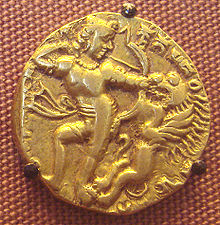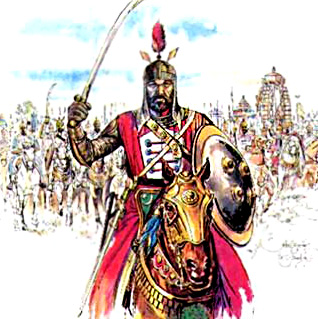Mehnaz Rahman
Bengal lands of ancient Hindustan, now Bangladesh, has been ruled by quite a few kings. Where there are kings, there are stories of rules, riches, bravery and generosity.
Puru the brave
Alexander was the king of Macedon, who conquered Greece and Persia. He defeated Puru, a king of Northern India, in the battle of Jhelum. The camp of Alexander was on the banks of the Jhelum. Onefine day,he was having a talk with his four generals on the Hindustani war policy, on elephants and on Puru himself.
Alexander: Oh! He is a brave man and a great soldier. I wish he were one of my generals.
Second General: He is a proud man, Your Majesty.
Alexander: A soldier is not a soldier if he is not proud. He was not frightened by my victories and refused to bow before me.
Soldier: Sir, Puru has been brought to the camp.
Puru enters with four Greek soldiers following him, and Alexander and the generals stand up to greet him. Puru joins the palms of his hands and raises them to his forehead to return the greeting.
Alexander: Well, how are you, Porus?
Puru: My name is Puru.
Alexander: Don’t you realize that you are my prisoner?
Puru: I do, but I’m still the lawful king of my country.
Alexander: How shall I treat you?
Puru: As a king should treat another king.
Alexander: Puru the brave, will you be a friend to me?
Puru: On one condition.
Alexander: What is that?
Puru: My kingdom should remain independent and you should treat me as your equal.
Alexander: Agreed, my brother.
Puru: I’ll do my best to be worthy of the friendship of Alexander the Great.
Alexander, with his undefeated army and arsenal, conquered most of the world including Central Asia (Afghanistan, Turkmenistan, Uzbekistan, Tajikistan). This refers to the Roman and Greek ancestry of this region. The already existing civilization there was the Indus Valley civilization, and all of it occurred before Christ. The advancement of civilization in Bengal dates back to four millennia. Bengal’s early history featured the consequent rise and tussle of Hinduism and Buddhism for dominance.
The Maurya Empire

Chandragupta Maurya (324 BC – 300 BC) was the first king of the Indian subcontinent. Alliance with Seleucus, a general for Alexander The Great, was very crucial to him. Exchanging ambassadors and gifting presents eventually proved that they established a harmonic relation.
The Greek population remained in the northwest part of Indian subcontinent under King Ashoka’s rule. As a result, Hinduism, Buddhism and Jainism have widely spread.
The Golden Empire

The Gupta Empire (320 AD – 550 AD) was the most glorious age of Bengal in every sense. Bengal had a strong trade link with Persia, Arabia and China that focused on its lucrative muslin textiles. “Navaratna” poets and the “Ajanta Elora” cave are two prominent legacies of the culturally creative Gupta dynasty.
The decline of the Gupta empire gave rise to King Harshavardhana (590 AD – 647 AD). His kingship hosted a Chinese wanderer, Hue-En-Sang, who mentioned Bengali Professor Shilbhadra of Nalanda University in his book.
The tale of Emperors so far suggests that the Greek, Roman, Persian, Arabian and Chinese have visited Hindustan as well as Bengal.
The Muslim Monarchy

Islam was introduced to the Indian people by Arabian traders in the seventh century. Though the dramatic shift of dominance was achieved by an Afghan emir, Sultan Mahmud (aka Mahmud of Ghazni). His brother, Muhamad Ghori, defeated King Prithviraj and laid the foundation of Muslim rule that lasted for several centuries. Another Afghan Muslim General, Muhammad Bin Bakhtiyar Khilji, monopolized Lakshmanaboti from Lakshman Sen which was then the capital of Bengal.
The diamond bigger than almonds
There was a time when Bengal had more diamonds than it had almonds. Ashrafis, the royal name of gold coins, of which you may have read in Arabian Nights, belongs as much to our ancestry as it does to the Arabs. Among all the stones, there was one named “Kohinur.” The “Kohinur” was brought to Bengal by Alauddin Khilji for Rani Padmabhati.
The Mughal Sultanate

The Mughal rule in Bengal started with Badshah Babur. Babur was a direct descendant of Turco-Mongol conqueror Timur through his father and of Genghis Khan through his mother. He influenced the expansion of Persianate ethos in Hindusthan which eventually overshadowed central Asian spirit of culture. Babur’s army was diverse in ethnicity and he was blessed to have the support of Afghans, Arabs, Iranians and Turkic people.
Humayun, Babur’s eldest son and heir, was a brave man of capricious nature. Sher Shah Suri, an ethnic Pashtun, took advantage of it to seize control of Delhi from Mughals. He sent him an ancient book of magic written in Sangskrit, and a golden statue of Bhishnu. Sher Shah succeeded to interrupt the Mughal monarchy. The Bhishnu from Bengal belongs to the Emperor Vikramaditya from Golden age.
Europian Colony

Vasco da Gama was a Portuguese explorer and the first European to reach Hindusthan. His voyage towards Asia introduced the West and the Orient by an oceanic route. He established one of his tents at Hoogli, West Bengal.
The Portuguese in Bangladesh were known as “Firingi,” and colonized the city of Chittagong. “Firingi Bazar,” near the bank of Karnaphuli River, is one of the relics that survived. Surprisingly, the first grammar book and dictionary of Bangla language was actually written by them. The Portuguese studied Sangskrit and Bangla, and tried to preach Christianity.
Eventually other European traders, mainly the Danish, the Dutch, the British and the French arrived and colonized Bengal.
The subcontinental blood has the essence of war and weapons in it. The new Bangladesh has gained a reputation of hospitality among enthusiast travelers. This attribute may have a thing to do with its diverse ancestry.

No comments:
Post a Comment